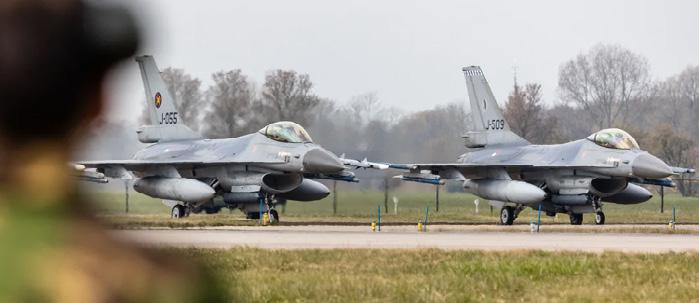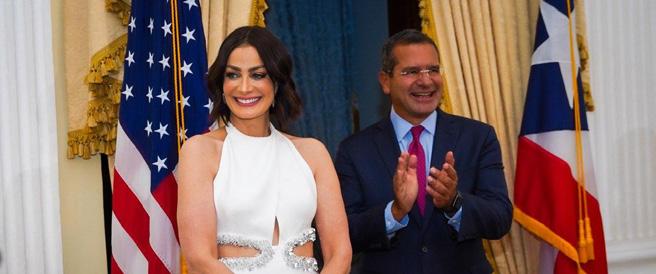
8 minute read
Why Ukraine needs those F-16s
By DAVID FRENCH
On Friday morning, local time, I received news of one of the best American decisions of the war: The White House would no longer block its European allies from supplying Ukraine with American-made F-16 fighters, a move that should greatly enhance Ukrainian military capabilities without significantly increasing the risk of unacceptable escalation in its conflict with Russia. (The decision still needs to be approved by some congressional leaders.)
Advertisement
The move came after a diplomatic blitz from Ukraine’s president, Volodymyr Zelenskyy, before this weekend’s Group of 7 summit in Hiroshima, Japan. European leaders had signaled a willingness to supply F-16s from their own stocks and train Ukrainian pilots in their use. But until now, the Biden administration had nixed the idea. The reversal is a major, and welcome, policy change.
I have spent the past week in Kyiv, and I can attest to the relentlessness of Ukrainian arguments for advanced fighters. I met with Ukrainian leaders across the full spectrum of government, including the defense minister, the foreign minister and ministers and other officials involved in law enforcement and economic reconstruction. I had never seen as consistent, disciplined messaging as I experienced here, all of it centered on a single, specific idea: Ukraine needs advanced Western fighters. Specifically, they were asking for American-made F-16s.
The high point came when I met with Oleksandr Kubrakov, the minister for communities, territories and infrastructure development, and even an infrastructure minister began the meeting by handing out a printed argument for supplying F-16s to Ukraine. I expected (and received) that argument from the defense minister, Oleksii Reznikov; I did not expect it from Kubrakov.
To an extent, they were preaching to the choir. I came to Ukraine already believing that Kyiv needed advanced fighters, but I was unsure whether it needed F-16s specifically. After all, European militaries also feature hundreds of Europeandesigned and -manufactured generation 4.5 fighter aircraft. To understand the critical importance of Ukraine’s request — and the rightness of the Biden administration’s decision — some basic background is necessary.
The jet fighter age is described in generations, which are categories of aircraft defined by their capabilities. There’s some disagreement as to how to classify different aircraft, but as a general matter, the first three generations, running from the debut of jet fighters to the middle of the Cold War, are completely obsolete and are not part of the debate. Fourthgeneration planes, like early models of the F-15 and F-16 and the Russian MIG-29 and Su-27, were the best planes of the Cold War and are still in service in most modern militaries, including Russia’s and Ukraine’s.
The apex of current fighter technology is fifth-generation stealth fighters, which include the American F-22 Raptor and F-35 Lightning II and Russia’s Su-57. Generation 4.5 is sandwiched between generations four and five: The fighters aren’t stealthy, but they have vastly upgraded avionics compared with fourth-generation fighters, and they can deploy more highly advanced armaments.
Generation 4.5 fighters include upgraded models of the American F-15, F-16 and F-18, as well as the Eurofighter Typhoon, Sweden’s Saab JAS-39 Gripen and France’s Dassault Rafale. Crucially, the list also includes the Russian Su-30, Su34 and Su-35. Russia has hundreds of generation 4.5 fighters. Ukraine has none. Instead it has a few dozen Soviet-era fourth-generation fighters.
And therein lies the problem. Don’t be deceived by 2022’s top-grossing movie, “Top Gun: Maverick,” in which (spoiler alert) Maverick, played by Tom Cruise, pilots a decades-old fourth-generation F-14 Tomcat to victory over a number of enemy fifth-generation fighters. In the real world, the generation gap would have been decisive.
According to Reznikov, the defense minister, Russia’s Su-35 (to take a key example) can hit targets at a range more than five times as great as Ukraine’s MIG-29 can. Moreover, such 4.5-generation fighters can carry a much greater array of advanced missiles than can Ukraine’s older fighters. This means that Ukrainian planes have a more limited capacity to provide air defense within the country and no ability to create air superiority at or near the zero line, the very edge of the battlefront, Reznikov said.
So why the need for American-made F-16s and not European-designed generation 4.5 fighters? The defense minister said that overall there may simply be too few of the latter to offer without dangerously depleting the fighter stocks of European allies. By contrast, not only are thousands of F-16s in service across American and allied militaries; many of those aircraft are being replaced by more advanced planes. Thus they are both numerous and available to Ukraine without degrading NATO capabilities.
Finally, it’s important to address the possibility of escalation. The F-16 — especially in the modest numbers under discussion — does not present a substantial threat to Russia itself. It presents a substantial threat only to the Russian invasion. It is not a true deep-strike aircraft, like the B-1 Lancer bomber or even the F-15E Strike Eagle. It is a weapon that Ukraine can deploy in a defensive capacity and that can strike relatively close behind the front line. It is exactly what Ukraine needs.
It is fair to argue about the timing of the Biden administration’s decision to release European F-16s. It’s a decision that could have been made earlier. Moreover, the administration is still allowing Ukraine to receive only F-16s belonging to European allies, not our own planes. But despite that shortcoming, which needs to be remedied soon, the fundamental reality is that allowing Ukraine any F-16s is the right decision. It’s the decision one makes when transitioning from a long-term strategy of simply keeping Ukraine alive toward a strategy of driving Russia from occupied Ukraine and — critically — deterring renewed Russian aggression after this war.

Perhaps the best short argument in support of the Biden administration’s decision was summed up by former Ukrainian defense minister Andriy Zagorodnyuk. He told me to “ask a NATO general how to win this war without aviation.” Providing Ukraine with advanced fighters not only makes its task easier; it’s a sign the Biden administration is ready to turn the page from helping Ukraine simply avoid defeat. Now we are starting to help Ukraine achieve victory — and maintain the peace we pray is soon to come.
Por Cybernews
LA FORTALEZA – En el marco de la celebración de los 30 años de haber sido coronada como Miss Universo, la actriz y presentadora puertorriqueña, Dayanara Torres Delgado, fue reconocida el martes, por el gobernador, Pedro Pierluisi, en un acto celebrado en el Salón de los Espejos de La Fortaleza.
“Hoy nos reunimos aquí para rendir homenaje y reconocer la belleza incomparable de esa excepcional mujer. Nos encontramos ante una figura que ha dejado una huella imborrable en el corazón de nuestro pueblo, en el mundo del espectáculo y en nuestras comunidades. Su presencia, carisma y talento han cautivado a millones de personas alrededor del mundo, y me place poder celebrar y destacar sus logros. Cuando hablo de su belleza, no me refiero únicamente a sus atributos físicos, sino a su genuina luz interior que irradia frente a todos los que ha tocado en su vida. Dayanara Torres personifica esa belleza en todas sus dimensiones. Natural de Toa Alta, es una gran embajadora de la Isla del Encanto y de nuestra cultura y tradición”, dijo el gobernador acompañado Torres y sus seres queridos.
Nacida el 28 de octubre de 1974 en Toa Alta, Puer- to Rico, a los 18 años Torres Delgado se convirtió en la tercera Miss Universo puertorriqueña. Al finalizar el año de su reinado y entregar la corona en Manila, Filipinas, conquistó la teleaudiencia de ese país, donde trabajó como conductora de programas de televisión y fue protagonista de 12 películas. Además, ha actuado en películas junto a William Forsythe, Tony Danza y LinManuel Miranda, entre otros. Como parte de su labor social, participó del concurso televisivo ‘Mira Quien Baila’ ganando una donación de $55 mil para el Hospital San Jorge en Puerto Rico y en el 2019, a raíz de su diagnóstico de cáncer de piel, educó a la población sobre esta enfermedad.
“Más allá de los aplausos y sus éxitos, Dayanara Torres ha demostrado ser una persona auténtica y humilde. Siempre ha mostrado su orgullo hacia sus raíces, ya que su amor por Puerto Rico y su compromiso con su gente son un ejemplo a seguir para todos nosotros. Hoy, al reconocer la belleza de Dayanara Torres, también celebramos su resiliencia y su espíritu inquebrantable. A través de los altibajos de la vida, ella ha demostrado que la verdadera belleza no se desvanece con el tiempo, sino que crece y se fortalece”, destacó el gobernador quien le entregó un Reconocimiento del Estado.

Por su parte, Dayanara Torres, quien estuvo acompañada de sus familiares y seres queridos, comentó visiblemente emocionada, que “llegar a Puerto Rico para celebrar esta semana se ha convertido en uno de los momentos más importantes de mi vida y no es solo por el hecho de celebrar, porque como boricuas nos encanta celebrar, sino por el significado que conlleva. Puerto Rico, vivo agradecida, bendecida por Dios por tantas bendiciones que me ha podido dejar vivir, por cada persona que puso en mi camino en el momento correcto, por mi pueblo de Toa Alta y su gente que con tanto sacrificio me apoyaron, pero en especial le agradezco a Dios por el cariño del pueblo, de ustedes”, añadió. En el evento de reconocimiento también estuvo presente el alcalde de Toa Alta, Clemente Agosto.
E L CAPITOLIO – La Cámara de Representantes aprobó el martes el Proyecto de la Cámara 1530, que busca establecer un marco regulatorio en términos de seguridad de datos para agencias públicas y empresas.
“El gobierno del futuro es uno con cada vez más procesos digitales para agilizar trámites, aumentar la eficiencia gubernamental y economizar tiempo y dinero a los ciudadanos”, expresó Ortiz González en
Cámara
declaraciones escritas.
“Nuestro propósito es que la isla cuente una legislación de avanzada que coloque a Puerto Rico a la vanguardia en el tema de la ciberseguridad y le provea a nuestros ciudadanos seguridad y confianza en los procesos gubernamentales”, añadió.
La nueva Ley de Ciberseguridad establece como principio de política pública que proveer seguridad a los datos gubernamentales es esencial para fomentar el desarrollo y crecimiento económico sostenible de todos los sectores en Puerto Rico. Entre otras dispo- siciones, prohíbe realizar cualquier tipo de pago por rescate en respuesta a un ransomware, con algunas excepciones, y crea la Oficina para la Evaluación de Incidentes Cibernéticos, adscrita al PRITS.
Además, la ley eleva a rango de ley el cargo del Principal Oficial de Seguridad Cibernética (Chief Information Security Officer) bajo la oficina del Puerto Rico Innovation and Technology Service (“PRITS”), nombrado por el Gobernador de Puerto Rico, por un término de diez años con el consejo y consentimiento del Senado de Puerto Rico.
EL CAPITOLIO – El presidente de la Cámara de Representantes Rafael Hernández Montañez, dio la bienvenida oficialmente el martes, a la representante del Distrito 29 (Cidra y Cayey), Gretchen Hau Irizarry, durante la sesión legislativa.
“Hoy, oficialmente le damos la bienvenida a la representante Gretchen Hau, quien recibe nuevas responsabilidades para con sus constituyentes y sobre todo, asume la responsabilidad de dar seguimiento a la gesta y legado de nuestro compañero que fue reclutado para trabajar en el cielo, José Aníbal Díaz Collazo”, expresó Hernández Montañez en declaraciones escritas.
Hernández Montañez también detalló las diferentes posiciones que ocupará la representante en las comisiones de la Cámara de Representantes. Hau Irizarry formará parte de la Comisión de Asuntos Internos, Comisión de Gobierno, Comisión de Desarrollo
Económico, Planificación, Comunicaciones, Alianzas Público Privadas y Energía.
Además, Hau Irizarry fue nombrada como presidenta de la Comisión de Transportación, Infraestructura y Obras Públicas.
Hau Irizarry asumió su posición en la Cámara el 16 de mayo, tras ser certificada como única candidata para ocupar el escaño vacante por el Distrito 19, dejado por el difunto legislador del Partido Popular Democrático.










